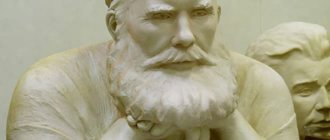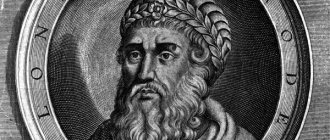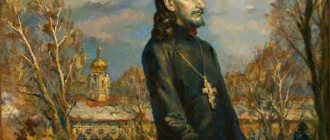Bible meaning
Who wrote the Bible (from the Greek for “book”) and what is it? These are 77 books written in different historical eras, combined into one. 50 books of the Old Testament (39 canonical and 11 non-canonical), 27 of the New Testament.
The Bible is unique; it contains all the main literary subjects, all genres of literature. And the question of the authorship of the books of the Bible has always occupied both secular scientists and ordinary believers. The study of any literary work begins with getting to know the author, the era in which he lived and worked. From a Christian point of view, the Bible has one Author - God, but these books were written by people. It is important for Christians to understand who these people were through whom God revealed His will to humanity.
Bible
There is no eyewitness testimony in the Gospel
The four Gospels of the New Testament are considered anonymous. Until the 2nd century there was no mention of Matthew, Mark, Luke and John. Whoever was considered the author of the Gospels did not say that they were witnesses to these events. They indicate only religious agitation.
Some scholars believe that the Gospels are compiled using a Jewish method of interpretation, which gives the biblical stories an updated form. Thus, Jesus' stay in the desert for 40 days is similar to Moses' 40-year exile in the land of Midian.
A beautiful Kazakh woman, whom the country's most famous comedian Nurlan Saburov is married to
How to eat grapefruit correctly so as not to feel bitterness
“Fool” and “simp”: how to refuse swearing now
Old and New Testaments
In theology, a “Covenant” is a contract between a person and God. The Old Testament consists of several contracts made by God with Adam, Noah, Abraham, Moses and David.
The agreement with Adam is a blessing for his possession of the whole earth, an instruction to be fruitful and multiply. The Noahic covenant consisted of God's promise to never repeat the flood and to prohibit people from killing. The agreement with Moses consisted of the Lord's promise to give him numerous descendants and give him his own land in exchange for faith and righteousness. The Mosaic Covenant is the removal of the Jews from Egypt and the Ten Commandments of God. The last covenant is a promise to David that Christ will be born in the House of David, that is, among the descendants of the king and the prophet.
The New Covenant was made by God with all people. In exchange for fulfilling the two commandments about love, He promises eternal life. Three covenants - Abrahamic, Mosaic and Davidic - were made with the Jewish people. The remaining three - Adam, Noah and New - with all humanity. In the Old Testament, God promises those who fulfill His commandments a prosperous life on earth. The New Testament gives people a chance at eternal life.
Before Christ's death on the cross, His descent into hell and Resurrection, it was impossible to get to heaven after death. The Savior literally destroyed previously unshakable laws and opened the way for us to the Kingdom of Heaven.
Knowing the source is essential
We usually check the origin of something we want to be sure about. For example, it is always important for us to know where the water we drink comes from. If we know that it is from a pure source, then we are sure that it can be drunk without harm to health. Likewise, we believe the news if we believe that the journalists can be trusted and the facts they present have been verified.
Knowing the source helps us evaluate the credibility of something. If we know the source of something, we either disregard it or consider it valuable and trustworthy. A lot depends on the source. The same is true of the Bible.
Who wrote the Bible?
How did the Bible come to be? The Old Testament indicates the authorship of most of the books - the books of the prophets and judges are named after the names of their creators. The Pentateuch was attributed to Moses, with the exception of a few lines added later. But in the 18th century, scholars Jean Astruc and Johann Eichhorn suggested that the Tanakh (Hebrew Bible) was created by merging two sources. This idea was prompted by the repetition of certain events and the alternation of two different names of God - Yahweh and Elohim. Moreover, the last Name sounds in the plural.
Later, scientists came to the conclusion that the Bible is a “patchwork quilt” of many texts by different authors from different times, written in Hebrew and Aramaic. For example, the book of the prophet Ezekiel consists of three different texts. But this scientific evidence does not make the Bible any less valuable to people.
As for the New Testament, there are also many controversial issues there. Someone, for example, argues furiously about the original number of books in the New Testament. There is no unity on this issue in the scientific community. Which indicates the high importance of the text and the spiritual information that this text carries.
Holy Spirit and the human spirit
It is important to see that people created by God not only have a mind, but also another internal part that is deeper than the mind. In the Bible, in Zech. 12:1 says that God “formed the spirit of man within him.” The “spirit of man” is our deepest part. Just like other parts of our being, it has its own special function. Our eyes exist to see, our ears exist to hear, and our human spirit exists to touch, receive, and contain God.
John 4:24 says:
God is Spirit, and those who worship Him must worship in spirit...
In this verse, the first word “Spirit” refers to the divine Spirit, and the second word refers to the human spirit. Through our human spirit we can worship God, have fellowship with God, and know God who is Spirit.
So what does this have to do with the origins of the Bible? When some people had fellowship with God in their spirit, they were moved, or carried, by the Holy Spirit to write down not their own words, but the words of God. The Scriptures are God's words, and they are holy because their source is God. They came to us from people moved by the Holy Spirit to speak and write words from God.
When and by whom was the Bible written - the Orthodox view
Who wrote the Bible and when? From the point of view of believers, the author is God. The texts of books were transferred to material media by prophets and writers by Divine inspiration.
When did the Bible appear? There is no exact date of its creation. As the Jewish people gradually matured spiritually, the Lord revealed to them more and more wisdom. Therefore, there are many “co-authors” of the Bible books. The care with which the prophetic texts were preserved testifies to the reverence that the people of Israel felt for the Creator for thousands of years.
Documentary hypothesis
In the 19th century, scientists identified other errors and inconsistencies. Julius Wellhausen believed that the Hexateuch was compiled on the basis of 4 documents by different authors. Each has its own theology and purpose. This theory is evidence of repeating stories - Creation and Flow. Genesis 7:17 says there was a flood of 40 days, and Genesis 8:3 says there was a flood of 150 days.
In Yahwist God is considered Jehovah. According to this concept, it is considered an anthropomorphic concept. The book with the letter E calls God Elohim. The theory of 4 documents has led to great doubts.
Authenticity of Biblical Texts
The authenticity and antiquity of many Old Testament and New Testament texts is confirmed by archeology. In the mid-20th century, a sensational discovery was made in the Judean Desert near the Dead Sea. In the Qumran caves, 190 fragments of manuscripts with passages from the Holy Scriptures and other religious texts dating back to the 1st - 2nd centuries AD were found. This confirmed the antiquity of the Christian texts from a historical point of view.
What language is the Bible written in? The Old Testament is in Hebrew. Although in some places there are passages in Aramaic, Phoenician and other languages. But due to the fact that the originals were written on papyrus scrolls or parchment, which are very poorly preserved, the Bible has survived to this day mostly in copies and translations.
Most of the New Testament texts we now have are written in Greek.
The Gospel of Matthew and Luke copied from the Gospel of Mark
Almost all scholars believe that the Gospel of Mark was written first. It is short, written in Greek, and includes many geographical inaccuracies.
Although this is supposed to be an independent account of the life of Jesus, the Gospels of Martha and Luke took information from the Gospel of Mark. Sometimes there is even copied text. The Matthew and Luke narratives have been improved upon from Mark.
The Bible and science - are there any contradictions?
There are many publications “exposing” religious texts, presenting their versions of events, etc. Strictly speaking, most of the events are confirmed by scientific theories; disputes are only about the interpretation of events.
There is archaeological evidence for the authenticity of the biblical narrative. For example, archaeologists near the Jordan River discovered the ruins of a city that many researchers consider Sodom. The age of the ruins coincides with the historical period described by the Bible - 3500 - 1540. BC. The city was abandoned at the end of the Bronze Age, which is completely consistent with biblical history.
The episode about the life of Jacob, whom his brothers sold into slavery to the Egyptians, is confirmed by a tablet found in one of the Egyptian tombs. The text on it tells about the terrible famine that occurred in Egypt and nearby countries. The pharaoh distributed the grain collected by the mayors, in return receiving full ownership of the population. The book of Genesis describes these events in exactly the same way. In addition, in Egypt, researchers found a sculpture of Pharaoh Thutmose III, which depicts Jews building a temple for the pharaoh. This episode proves the authenticity of the information about the Egyptian slavery of the Jews.
The Bible does not contradict itself. Yes, there are a lot of repeating places. There are at first glance incomprehensible or absurd texts. There are strange chapters that seem to have been inserted into the narrative for no reason. But this is the depth of Holy Scripture, that with each reading it reveals more and more meanings to the attentive reader.
Deuteronomy appeared as royal propaganda
The book of Deuteronomy was compiled during the reign of King Josiah in the 7th century to identify new laws that would strengthen the status of the clergy. This was required to create a special religion for the Kingdom of Judah.
After the release of the New Code, a rethinking of the old provisions took place. The type of his narrative is intended for reading by residents of cities and villages under the rule of the Temple of Jerusalem. The law written for the Temple is a replacement for the old law that was written in Exodus 20:24. This indicates that Deuteronomy was composed after the people of Israel became desert wanderers.
Where to put chlorophytum to get maximum health benefits from it
What “pitfalls” should you be wary of depending on your month of birth?
A puppy rescued thanks to the police in Khanty-Mansiysk Autonomous Okrug has found an owner
List of holy books
A new religion arose in the 1st century - Christianity, which inherited problems from Judaism along with the Old Testament. Deciding what deserved to be transferred from the old faith to the new and what did not was very difficult. Christians previously became familiar with a large number of biblical books in Greek, and not in the original Hebrew. This introduced a certain amount of distortion and misunderstanding due to the nature of the translation.
As long as Christians lived in independent, scattered and secret societies, there was no talk of a canon. Each presbyter or deacon independently decided which books to read to his flock. The words of Jesus Christ meant more to them than their Jewish heritage. Christians decided to make a decision about the Old Testament only in the 7th century, after they had resolved the most difficult internal church disputes and defined the most important theological concepts.
In the future, the Eastern churches will be called Orthodox.
In 692, at the Trullo Council of the Eastern Churches, a decision was made to recognize 39 canonical books as sacred (those that were recognized by the Jews) and 11 non-canonical (those that, for various reasons, were rejected by the Sanhedrin). This list of 50 Old Testament books is still read in traditional Orthodox society.
However, the Bishop of Rome (who will become the head of the Catholic Church in the near future) refused to sign the conclusion of the Trullo Council. The thing is that among the decisions of the council there were condemnations of some customs that were accepted by the Western Church, but rejected by the Eastern. By refusing to sign the decisions of the council, the head of the Roman church also refused to approve the books that would be included in the Old Testament. Therefore, Catholics had to live without a canon until the 16th century.
At the Council of Trent only in 1546, a list was approved; it included 46 books. However, among the Eastern churches the agreement did not last long. Later, many of them revised the canon, which was adopted by the Trullo Council. Today, many of them have a very different list of books of the Old Testament. For example, the canon of the Ethiopian Orthodox Church includes 54 books.
In the 16th century, the emerging Protestants also thought about the canon of the Old Testament along with Catholics. Trying to cleanse Christianity of all unnecessary things, the reformers also approached the Jewish heritage very critically. Some followers of Martin Luther decided that those books preserved in the original language should be recognized as canonical. All the rest, which reached them only in Greek translations, can only claim the status of apocrypha. That is why there are only 39 books in the Protestant Old Testament.
Regarding the New Testament, the followers of Jesus Christ agreed in the most organized way. It included 27 books, recognizing almost all Christian denominations, with rare exceptions. Such as the Acts of the Apostles, the four Gospels, the 21 Epistles of the Apostles and the Revelation of John the Theologian.
Thus, it turns out that the Orthodox Bible contains 77 books, the Catholic Bible has 73 books, and the Protestant Bible has 66 books.
Simon Magus and Paul - one person
Some of the theories presented here are supported by scientists, while others are more speculative. One of them refers to Simon Magus. The Fathers of the Church consider him the creator of the Gnostic heresy, which calls for hostility towards God, Jews, and the Torah. Therefore, many do not know that the Apostle Paul may be Simon.
Photo from the archive: fans of Dmitry Pevtsov did not recognize him in the photo in his youth
Not yet Novoseltsev: what young Myagkov looked like in his first film (photo)
Will make you work hard: how to “tame” a fashionable beauty monster
Paul's letters are sometimes not very consistent. The Scriptures are chaotic and incoherent. Some facts contradict theology. Some scholars believe that Paul's writings were modified to soften the Gnostic content. This was probably done by Simon the Magus or his follower.
The Pastoral Epistles are fake
The Epistles to Timothy and Titus differ in writing style and biblical meaning from the Epistles of Paul. This indicates that there was a forger working here who wanted to feel the influence that Paul had. Of the 848 words, many were not used by Paul.
The literary style also speaks about falsification. Paul uses emotional Greek; the Epistles are meditative. Scientists believe that the forgeries were written by Polycarp of Smyrna.
Forgotten Gospel Q
The Gospels of Matthew and Luke have general information that is not found in the Gospel of Mark. Scholars believe that there was another document that was lost, because an unfamiliar source is often found, listed as Q. It likely contained significant biblical information.
Q is considered a collection of statements. Matthew and Luke included some sayings in the context, but they used different styles. After the restoration of Q, researchers realized that since Q does not include the Passion of the Lord. The author of this document classified Jesus as a teacher of wisdom. And his death was not considered salvation for him.








